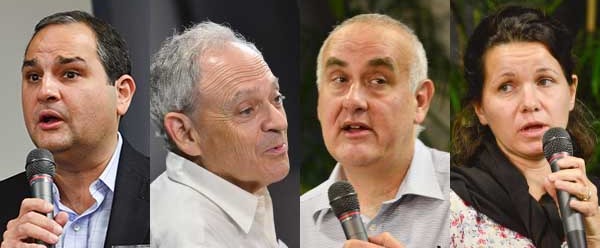FARA Energy Ball Research Panel
There were many excellent speakers at this year’s FARA Energy Ball that covered a wide variety of topics – from recent scientific breakthroughs to first-hand experiences of those suffering from the disease. Three leaders in the Friedreich’s ataxia research community spoke regarding current genetic approaches to therapies and shared some of their most recent findings.
One of the speakers was Joel Gottesfeld, Ph.D. Dr. Gottesfeld currently works as a professor in the Department of Molecular Biology at the Scripps Research Institute. He studies several genetic human diseases – one of which is Friedreich’s ataxia. In addition to studying general characteristics of this disease Dr. Gottesfeld and his staff are working to develop new treatments.
Their research has led to the discovery of a new group of histone deacetylase (HDAC) inhibitors. These small molecules were found to reverse the heterochromatin-mediated silencing of the frataxin (FXN) gene. Further research with mouse models has shown that these HDAC inhibitors can cross the blood brain barrier, do not appear to cause toxicity at expected therapeutic levels, and do act as HDAC inhibitors in the mouse brain. Even more promising, they demonstrated that the HDAC inhibitors increased the FXN gene expression and protein in the blood cells of FA patients.
Another speaker was Hélène Puccio, Ph.D. Dr. Puccio is the head of a research team at the Institute of Genetics and Molecular and Cellular Biology located at the University of Strasbourg, France, as well as a research director at the Insititute de Santé et de la Recherche Médicale (INSERM.) She has concentrated her research on the pathophysiological mechanisms involved in recessive ataxias, like Friedreich’s ataxia, in order to develop new animal and cell models.
During one of her studies she and her colleagues were able to use mice with no frataxin in their heart to demonstrate that gene therapy can be used to reverse heart damage and correct the mitochondrial metabolism. This finding leads to the possibility of using gene therapy as a treatment for the disease.
Finally, Massimo Pandolfo, MD works for Université Libre de Bruxelles at the Hôspital Erasme and has been the principal investigator of the European Friedreich’s Ataxia Consortium for Translational Studies (EFACTS.) Dr. Pandolfo led an international collaboration that discovered the FA gene back in 1996 and has continued to contribute in many ways over the years. He has been working with everything from research trials to clinical care for patients. In addition, he has contributed to our understanding of the disease process, clinical characteristics, and has helped to advance drug development.

